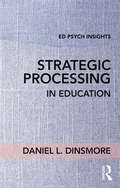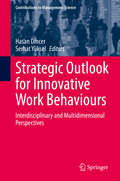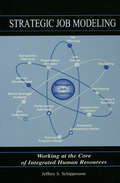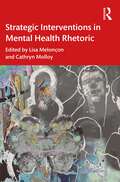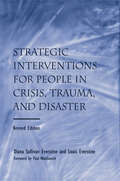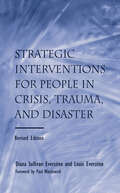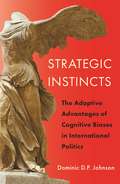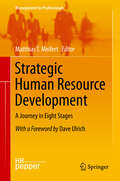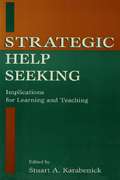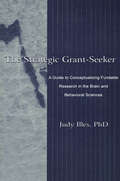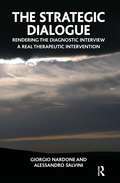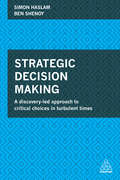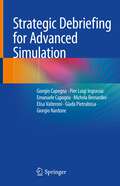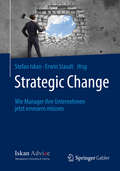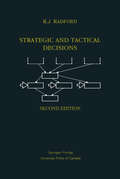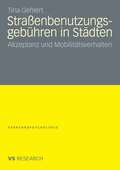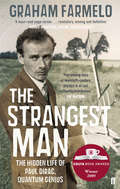- Table View
- List View
Strategic Processing in Education (Ed Psych Insights)
by Daniel L. DinsmoreWhile there are certainly numerous influences on individuals’ learning and performance, cognitive strategies are the processes most directly related to making meaningful progress on a learning task or problem. Written by a leading expert on strategic processing, this book situates the topic within the broader context of educational psychology research and theory and brings it to a wider audience. With chapters on the fundamentals of domain-general and domain-specific strategies, connections to other constructs, and advice for instructing students, this concise volume is designed for any education course that includes learning or study strategies in the curriculum. It will be indispensable for student researchers and both pre- and in-service teachers.
Strategic Processing in Education (Ed Psych Insights)
by Daniel L. DinsmoreWhile there are certainly numerous influences on individuals’ learning and performance, cognitive strategies are the processes most directly related to making meaningful progress on a learning task or problem. Written by a leading expert on strategic processing, this book situates the topic within the broader context of educational psychology research and theory and brings it to a wider audience. With chapters on the fundamentals of domain-general and domain-specific strategies, connections to other constructs, and advice for instructing students, this concise volume is designed for any education course that includes learning or study strategies in the curriculum. It will be indispensable for student researchers and both pre- and in-service teachers.
Strategic Outlook for Innovative Work Behaviours: Interdisciplinary and Multidimensional Perspectives (Contributions to Management Science)
by Hasan Dincer Serhat YükselThis book presents various perspectives on innovative work behaviour, focusing on problem recognition, idea generation, idea promotion and the realisation of these ideas. It first highlights important corporate issues, such as uncertainty, performance management, technological infrastructure, and strategy development, and subsequently presents studies that offer solutions. Further, the book evaluates the significance of research and development, effective communication and corporate governance. Lastly, it discusses the implications of idea realisation, examining resource dependence theory, organizational trust and eco-innovations.
Strategic Job Modeling: Working at the Core of Integrated Human Resources
by Jeffery S. Schippmann(USE FOR PRACTITIONER/BUSINESS PIECES) In an increasingly knowledge-based economy, a company's success hinges on the quality of its people. People set strategy, make decisions, build relationships, and drive change. Businesses possess a powerful advantage if their people do their jobs better and faster than the competition. The need for more sophisticated, integrated, and strategically linked human resource applications (e.g., selection systems, training programs, and performance management interventions) is recasting the very role of HR. One of the critical tools in the HR professionals' toolkit that has been used to create these applications is job analysis. However, much of today's job analysis practice has failed to keep up with the evolutionary pace. This book is about a "next generation" job analysis method that involves translating business strategies into work performance and competency requirements, and using this information and data to create an architecture that can be used to support the sophisticated HR applications and enterprise resource planning systems that will be a part of high-performance third millennium organizations. Numerous case studies, applied examples, and project management tips contribute to the practice-oriented design of the book to illustrate a personnel research activity that is essentially an ongoing organizational development intervention. (USE THIS COPY FOR TEXTBOOK PIECES) The business landscape is changing and becoming more complex. Furthermore, human resources is at the vortex of much of what is changing. The need for more sophisticated, integrated, and strategically linked human resource applications (e.g., selection systems, training programs, and performance management interventions) is recasting the very role of HR. One of the critical tools in the HR professionals' toolkit that has been used to create these applications is job analysis. However, much of today's job analysis practice has failed to keep up with the evolutionary pace. This book is about a "next generation" job analysis method that involves translating business strategies into work performance and competency requirements, and using this information and data to create an architecture that can be used to support the sophisticated HR applications and enterprise resource planning systems that will be a part of high-performance third millennium organizations. Numerous case studies, applied examples, and project management tips contribute to the practice-oriented design of the book to illustrate a personnel research activity that is essentially an ongoing organizational development intervention.
Strategic Job Modeling: Working at the Core of Integrated Human Resources
by Jeffery S. Schippmann(USE FOR PRACTITIONER/BUSINESS PIECES) In an increasingly knowledge-based economy, a company's success hinges on the quality of its people. People set strategy, make decisions, build relationships, and drive change. Businesses possess a powerful advantage if their people do their jobs better and faster than the competition. The need for more sophisticated, integrated, and strategically linked human resource applications (e.g., selection systems, training programs, and performance management interventions) is recasting the very role of HR. One of the critical tools in the HR professionals' toolkit that has been used to create these applications is job analysis. However, much of today's job analysis practice has failed to keep up with the evolutionary pace. This book is about a "next generation" job analysis method that involves translating business strategies into work performance and competency requirements, and using this information and data to create an architecture that can be used to support the sophisticated HR applications and enterprise resource planning systems that will be a part of high-performance third millennium organizations. Numerous case studies, applied examples, and project management tips contribute to the practice-oriented design of the book to illustrate a personnel research activity that is essentially an ongoing organizational development intervention. (USE THIS COPY FOR TEXTBOOK PIECES) The business landscape is changing and becoming more complex. Furthermore, human resources is at the vortex of much of what is changing. The need for more sophisticated, integrated, and strategically linked human resource applications (e.g., selection systems, training programs, and performance management interventions) is recasting the very role of HR. One of the critical tools in the HR professionals' toolkit that has been used to create these applications is job analysis. However, much of today's job analysis practice has failed to keep up with the evolutionary pace. This book is about a "next generation" job analysis method that involves translating business strategies into work performance and competency requirements, and using this information and data to create an architecture that can be used to support the sophisticated HR applications and enterprise resource planning systems that will be a part of high-performance third millennium organizations. Numerous case studies, applied examples, and project management tips contribute to the practice-oriented design of the book to illustrate a personnel research activity that is essentially an ongoing organizational development intervention.
Strategic Interventions in Mental Health Rhetoric
by Lisa MelonçonOffering rhetorically informed strategic interventions, this innovative collection moves beyond critiques of mental health issues, problems, and care. With sections that focus on methodological, cultural and legal, and pedagogical interventions, readers will find an engaging discussion of a discrete mental health phenomenon as well as a clear interventional takeaway in each chapter. Contributors make use of critical discourse analyses, ethnographic inquiries, autoethnographic inquiries, case studies, and textual analyses to engage such mental health research topics as postpartum depression among Chinese mothers; insanity pleas; anosognosia; issues of intimacy, access, and embodiment in research projects; community support groups; Black mental health; women in Alcoholics Anonymous; and mental health in faculty workshops and university online health tools. The authors and editors create scholarship on mental health that explicitly builds productive methodological, theoretical, and practical bridges among scholars and teachers in the various specialties of writing and communication. This collection will interest scholars, students, and practitioners in health and medical humanities; rhetoric of health and medicine; health communication; medical anthropology; scientific and technical communication; disability studies; and rhetorical studies generally.
Strategic Interventions in Mental Health Rhetoric
by Lisa Melonçon Cathryn MolloyOffering rhetorically informed strategic interventions, this innovative collection moves beyond critiques of mental health issues, problems, and care. With sections that focus on methodological, cultural and legal, and pedagogical interventions, readers will find an engaging discussion of a discrete mental health phenomenon as well as a clear interventional takeaway in each chapter. Contributors make use of critical discourse analyses, ethnographic inquiries, autoethnographic inquiries, case studies, and textual analyses to engage such mental health research topics as postpartum depression among Chinese mothers; insanity pleas; anosognosia; issues of intimacy, access, and embodiment in research projects; community support groups; Black mental health; women in Alcoholics Anonymous; and mental health in faculty workshops and university online health tools. The authors and editors create scholarship on mental health that explicitly builds productive methodological, theoretical, and practical bridges among scholars and teachers in the various specialties of writing and communication. This collection will interest scholars, students, and practitioners in health and medical humanities; rhetoric of health and medicine; health communication; medical anthropology; scientific and technical communication; disability studies; and rhetorical studies generally.
Strategic Interventions for People in Crisis, Trauma, and Disaster: Revised Edition
by Diane Sullivan Everstine Louis EverstineStrategic Interventions for People in Crisis, Trauma, and Disaster enables therapists to walk into difficult situations with a thorough understanding of interactional dynamics and a plan of action. With the stressful turbulence of our present culture, more and more clinicians are called upon to intervene in crisis situations. Violent interactions, once considered rare or beyond the province of the therapist, have become familiar events to many practitioners. This volume provides them with both the theoretical background and practical techniques to help people learn from crisis experiences and move toward change and growth. Of special interest are practical guidelines and specific intervention strategies for conducting psychotherapy with different types of violent persons and of victims. Treatment principles for each crisis situation are then illustrated in detailed case studies. As the authors demonstrate, with these troubled people a therapist must be ready to make quick decisions, draw upon all available resources from the family and community, and offer continuing support as traumas are worked through and new behavior patterns are learned. In addition, the authors discuss the legal and ethical responsibilities of the therapist.
Strategic Interventions for People in Crisis, Trauma, and Disaster: Revised Edition
by Diane Sullivan Everstine Louis EverstineStrategic Interventions for People in Crisis, Trauma, and Disaster enables therapists to walk into difficult situations with a thorough understanding of interactional dynamics and a plan of action. With the stressful turbulence of our present culture, more and more clinicians are called upon to intervene in crisis situations. Violent interactions, once considered rare or beyond the province of the therapist, have become familiar events to many practitioners. This volume provides them with both the theoretical background and practical techniques to help people learn from crisis experiences and move toward change and growth. Of special interest are practical guidelines and specific intervention strategies for conducting psychotherapy with different types of violent persons and of victims. Treatment principles for each crisis situation are then illustrated in detailed case studies. As the authors demonstrate, with these troubled people a therapist must be ready to make quick decisions, draw upon all available resources from the family and community, and offer continuing support as traumas are worked through and new behavior patterns are learned. In addition, the authors discuss the legal and ethical responsibilities of the therapist.
Strategic Instincts: The Adaptive Advantages of Cognitive Biases in International Politics (Princeton Studies in International History and Politics #172)
by Dominic D. Johnson"A very timely book."—Anne-Marie Slaughter, CEO of New AmericaHow cognitive biases can guide good decision making in politics and international relationsA widespread assumption in political science and international relations is that cognitive biases—quirks of the brain we all share as human beings—are detrimental and responsible for policy failures, disasters, and wars. In Strategic Instincts, Dominic Johnson challenges this assumption, explaining that these nonrational behaviors can actually support favorable results in international politics and contribute to political and strategic success. By studying past examples, he considers the ways that cognitive biases act as “strategic instincts,” lending a competitive edge in policy decisions, especially under conditions of unpredictability and imperfect information.Drawing from evolutionary theory and behavioral sciences, Johnson looks at three influential cognitive biases—overconfidence, the fundamental attribution error, and in-group/out-group bias. He then examines the advantageous as well as the detrimental effects of these biases through historical case studies of the American Revolution, the Munich Crisis, and the Pacific campaign in World War II. He acknowledges the dark side of biases—when confidence becomes hubris, when attribution errors become paranoia, and when group bias becomes prejudice. Ultimately, Johnson makes a case for a more nuanced understanding of the causes and consequences of cognitive biases and argues that in the complex world of international relations, strategic instincts can, in the right context, guide better performance.Strategic Instincts shows how an evolutionary perspective can offer the crucial next step in bringing psychological insights to bear on foundational questions in international politics.
Strategic Instincts: The Adaptive Advantages of Cognitive Biases in International Politics (Princeton Studies in International History and Politics #172)
by Dominic D. Johnson"A very timely book."—Anne-Marie Slaughter, CEO of New AmericaHow cognitive biases can guide good decision making in politics and international relationsA widespread assumption in political science and international relations is that cognitive biases—quirks of the brain we all share as human beings—are detrimental and responsible for policy failures, disasters, and wars. In Strategic Instincts, Dominic Johnson challenges this assumption, explaining that these nonrational behaviors can actually support favorable results in international politics and contribute to political and strategic success. By studying past examples, he considers the ways that cognitive biases act as “strategic instincts,” lending a competitive edge in policy decisions, especially under conditions of unpredictability and imperfect information.Drawing from evolutionary theory and behavioral sciences, Johnson looks at three influential cognitive biases—overconfidence, the fundamental attribution error, and in-group/out-group bias. He then examines the advantageous as well as the detrimental effects of these biases through historical case studies of the American Revolution, the Munich Crisis, and the Pacific campaign in World War II. He acknowledges the dark side of biases—when confidence becomes hubris, when attribution errors become paranoia, and when group bias becomes prejudice. Ultimately, Johnson makes a case for a more nuanced understanding of the causes and consequences of cognitive biases and argues that in the complex world of international relations, strategic instincts can, in the right context, guide better performance.Strategic Instincts shows how an evolutionary perspective can offer the crucial next step in bringing psychological insights to bear on foundational questions in international politics.
Strategic Human Resource Development: A Journey in Eight Stages (Management for Professionals)
by Matthias T. MeifertIn an era that has brought new and unexpected challenges for virtually every company, one would be hard-pressed to find any responsible manager who is not thinking about what the future will bring. In the wake of these challenges, strategic planning has moved from being the reserve of large corporations to becoming an essential need for even small and medium-sized enterprises. But what good is even the most convincing strategic concept if the company’s people are unwilling or unable to put it into practice? The key is to develop people, and to develop them not only for the work of today, but also for the challenges that the future holds. Strategic HR development has become a decisive force for the success of any business. This book, edited by Matthias T. Meifert, shows us which basic considerations we need to remember and what strategic HR development means in practice. Its interesting and vivid approach takes the reader on a tour of the eight stages of HR development, introduces the critical factors, and highlights many practical recommendations for strategic HR development practice in business.
Strategic Help Seeking: Implications for Learning and Teaching
by Stuart A. KarabenickThere is considerable agreement that more successful learners are active, engaged, and self-regulating learners who understand and are motivated to apply learning strategies under appropriate conditions. One important strategic activity is seeking help when necessary, rather than giving up or engaging in fruitless persistence. Research on strategic help seeking has matured significantly in recent years. This volume captures the current state of knowledge, research, and theory on help seeking as a strategic learning resource. It is international in scope, with contributors from the U.S., the Netherlands, Japan, and Israel. As a whole, the book suggests that strategic (adaptive) help seeking is a critical school readiness skill that is facilitated by mastery-oriented classroom achievement and social goals, by teachers who invite questions rather than those who ask them, and by cultural characteristics that support student inquiry. A conceptual overview is followed by three chapters that examine help seeking from complementary theoretical perspectives and make important distinctions between forms of help seeking; two chapters that focus on how learners' achievement and social goals affect classroom help seeking; one chapter specifically devoted to cross-cultural comparisons of help seeking in Western cultures and in Japan; two chapters that examine the most frequent manifestation of help seeking--that of question asking; and one chapter that explores help-seeking in the information age (the library reference process, information technology, and computer-mediated communication). All chapters include attention to the implications of research and theory for help seeking in instructional settings. Strategic Help Seeking is an excellent resource for educational researchers and practitioners including teachers, school administrators, instructional designers, reference librarians.
Strategic Help Seeking: Implications for Learning and Teaching
by Stuart A. KarabenickThere is considerable agreement that more successful learners are active, engaged, and self-regulating learners who understand and are motivated to apply learning strategies under appropriate conditions. One important strategic activity is seeking help when necessary, rather than giving up or engaging in fruitless persistence. Research on strategic help seeking has matured significantly in recent years. This volume captures the current state of knowledge, research, and theory on help seeking as a strategic learning resource. It is international in scope, with contributors from the U.S., the Netherlands, Japan, and Israel. As a whole, the book suggests that strategic (adaptive) help seeking is a critical school readiness skill that is facilitated by mastery-oriented classroom achievement and social goals, by teachers who invite questions rather than those who ask them, and by cultural characteristics that support student inquiry. A conceptual overview is followed by three chapters that examine help seeking from complementary theoretical perspectives and make important distinctions between forms of help seeking; two chapters that focus on how learners' achievement and social goals affect classroom help seeking; one chapter specifically devoted to cross-cultural comparisons of help seeking in Western cultures and in Japan; two chapters that examine the most frequent manifestation of help seeking--that of question asking; and one chapter that explores help-seeking in the information age (the library reference process, information technology, and computer-mediated communication). All chapters include attention to the implications of research and theory for help seeking in instructional settings. Strategic Help Seeking is an excellent resource for educational researchers and practitioners including teachers, school administrators, instructional designers, reference librarians.
The Strategic Grant-seeker: A Guide To Conceptualizing Fundable Research in the Brain and Behavioral Sciences
by Judy IllesAn understanding of each of the critical components of the funding process is key to meeting the challenges posed by the increasingly intense competition for research funds. This book is a vital tool for those who want to build and maximize their grant support. Although many publications provide valuable information about proposal preparation, few cover the full spectrum of issues--from planning through execution--in the funding process. The book leads off with a discussion of the relationship between researchers and the funding environment, features of good short- and long-range funding plans, characteristics of funding organizations in terms of funding power, mission, and priorities, and the manner in which funding information is disseminated. Succeeding chapters focus on the actual development of the many different types of opportunities--research projects, multicomponent research programs, career development and training programs, and small business innovation research. These chapters emphasize conceptualizing an idea, optimizing the researcher-sponsor match, and testing the concept for competitiveness. Further chapters deliver strategies for translating research ideas into written proposals, preparing administrative sections and communicating with a sponsor. The final chapters are dedicated to the outcomes of the proposal process: reviews, rebuttals, and resubmissions; and to progress reports and future proposals for maintaining and building on funding. Flowcharts, examples, and summary tables are used throughout the text to highlight key points.
The Strategic Grant-seeker: A Guide To Conceptualizing Fundable Research in the Brain and Behavioral Sciences
by Judy IllesAn understanding of each of the critical components of the funding process is key to meeting the challenges posed by the increasingly intense competition for research funds. This book is a vital tool for those who want to build and maximize their grant support. Although many publications provide valuable information about proposal preparation, few cover the full spectrum of issues--from planning through execution--in the funding process. The book leads off with a discussion of the relationship between researchers and the funding environment, features of good short- and long-range funding plans, characteristics of funding organizations in terms of funding power, mission, and priorities, and the manner in which funding information is disseminated. Succeeding chapters focus on the actual development of the many different types of opportunities--research projects, multicomponent research programs, career development and training programs, and small business innovation research. These chapters emphasize conceptualizing an idea, optimizing the researcher-sponsor match, and testing the concept for competitiveness. Further chapters deliver strategies for translating research ideas into written proposals, preparing administrative sections and communicating with a sponsor. The final chapters are dedicated to the outcomes of the proposal process: reviews, rebuttals, and resubmissions; and to progress reports and future proposals for maintaining and building on funding. Flowcharts, examples, and summary tables are used throughout the text to highlight key points.
The Strategic Dialogue: Rendering the Diagnostic Interview a Real Therapeutic Intervention
by Giorgio Nardone Alessandro SalviniThe Strategic Dialogue is a fine strategy by which one can achieve maximum results with minimum effort. It was developed through a natural evolutionary process from previous treatments for particular pathologies, and composed of therapeutic stratagems and specific sequences of ad hoc maneuvres constructed for different types of problems. This book represents both the starting and finishing line of all of the research, clinical practice, and managerial consulting performed by the authors over a fifteen year period at the Centro Terapia Strategica of Arezzo (Strategic Therapy Center). This work can be referred to as the finishing line because the Strategic Dialogue, an advanced therapeutic method of conducting a therapy session and inducing radical changes rapidly in the patient, represents the culmination of all that has been achieved so far in the field.
The Strategic Dialogue: Rendering the Diagnostic Interview a Real Therapeutic Intervention
by Giorgio Nardone Alessandro SalviniThe Strategic Dialogue is a fine strategy by which one can achieve maximum results with minimum effort. It was developed through a natural evolutionary process from previous treatments for particular pathologies, and composed of therapeutic stratagems and specific sequences of ad hoc maneuvres constructed for different types of problems. This book represents both the starting and finishing line of all of the research, clinical practice, and managerial consulting performed by the authors over a fifteen year period at the Centro Terapia Strategica of Arezzo (Strategic Therapy Center). This work can be referred to as the finishing line because the Strategic Dialogue, an advanced therapeutic method of conducting a therapy session and inducing radical changes rapidly in the patient, represents the culmination of all that has been achieved so far in the field.
Strategic Decision Making: A Discovery-led Approach to Critical Choices in Turbulent Times
by Simon Haslam Ben ShenoyMaking strategic decisions is a fundamental skill for leaders and managers. However, in a business environment that is in a constant state of change, making strategic decisions has never been more difficult. Strategic Decision Making addresses this challenge by providing a framework that can be used to make sound decisions in an uncertain world. Structured around the core concepts of framing, experimenting and scaling, this book will ensure that efforts are focused where the need is greatest, that interventions are tested, evaluated and revised if necessary and that successful initiatives are effectively rolled out across the business.Packed with real world examples and backed up by academic research, Strategic Decision Making will allow today's leaders and the leaders of tomorrow to make successful and defensible business choices. It shows how to: avoid decision-making bias; overcome organizational inertia; manage the difficulties of rigid organizational structures and avoid being side tracked by outdated or irrelevant experience. Essential reading for business practitioners and management students alike, this comprehensive guide provides a robust approach to achieving strategic success.
Strategic Decision Making: A Discovery-led Approach to Critical Choices in Turbulent Times
by Simon Haslam Ben ShenoyMaking strategic decisions is a fundamental skill for leaders and managers. However, in a business environment that is in a constant state of change, making strategic decisions has never been more difficult. Strategic Decision Making addresses this challenge by providing a framework that can be used to make sound decisions in an uncertain world. Structured around the core concepts of framing, experimenting and scaling, this book will ensure that efforts are focused where the need is greatest, that interventions are tested, evaluated and revised if necessary and that successful initiatives are effectively rolled out across the business.Packed with real world examples and backed up by academic research, Strategic Decision Making will allow today's leaders and the leaders of tomorrow to make successful and defensible business choices. It shows how to: avoid decision-making bias; overcome organizational inertia; manage the difficulties of rigid organizational structures and avoid being side tracked by outdated or irrelevant experience. Essential reading for business practitioners and management students alike, this comprehensive guide provides a robust approach to achieving strategic success.
Strategic Debriefing for Advanced Simulation
by Giorgio Capogna Pier Luigi Ingrassia Emanuele Capogna Michela Bernardini Elisa Valteroni Giada Pietrabissa Giorgio NardoneThis book provides an in-depth and complete guide explaining how to incorporate the strategic dialogue and strategic communication methods into the debriefing after the scenario, characteristics that make it unique. After examining all the aspects that allow a correct use of the simulation, such as knowledge of models, logical schemes, use of the different simulators, planning of the didactic activities and of learning process, this practical book aims to explore the advanced technique of the strategic debriefing. It encourages not only those who are approaching this new debriefing tool but also it provides a useful update to all those who are already more familiar with the standard debriefing after simulation technique.The strategic language, an effective tool in strategic psychotherapy and business problem solving, is ideal and complementary to the standard debriefing methods, making them more performing and functional because, next to common logic, it makes use of non-ordinary logical language. The book is intended for healthcare simulation debriefers and instructors, for hospitals’ managers, university teachers and to all the physicians who are increasingly showing interest in active teaching processes with simulation.
Strategic Change: Wie Manager ihre Unternehmen jetzt erneuern müssen
by Stefan Iskan Erwin StaudtChange in der Krise kann jeder - das ist keine Management-Kunst. Doch wie bekommen Sie Ihre Mannschaft bewegt, wenn der Veränderungsdruck noch nicht in den Quartalszahlen spürbar ist? Change-Prozesse gestalten heißt: das Spiel kontrollieren. Für derartige Prozesse in Unternehmen, die kein Sanierungsfall sind, sind völlig andere Kompetenzen gefragt als beim klassischen Restrukturierungsmanagement. Genau hier setzen Stefan Iskan und Erwin Staudt mit ihrem Autorenteam an. Sie verdeutlichen, dass in Wirtschaft und Gesellschaft ein völlig anderes Verständnis von Change Management benötigt wird. Und zwar eines, das - jenseits von Krisen- und Turnaround- Management - dem bewussten und strategischen Wandel nahekommt und Veränderungsbereitschaft als neuen kritischen Erfolgsfaktor, ja sogar neuen Input-Faktor, in den Unternehmen betrachtet.„Dieses Buch ist nichts für Manager, die in kleinen Schritten arbeiten. Die Herausgeber und ihr Autorenteam beweisen Mut, indem sie das „Change Desaster“ in Unternehmen ungeschönt beim Namen nennen und ungemütliche Fragen aufwerfen. Die Autoren wissen, wovon sie sprechen. Und das zeigen sie hier mit großer Leidenschaft.“Thomas Blank, Chief Executive Officer Area Central Europe bei Agility & Member of the European Management Board
Strategic and Tactical Decisions
by K.J. RadfordMuch of the work that has been done in the last fifty years in the area of decision analysis has been concerned with situations in which formal mathematical models of the decision process can be used. For example, deterministic models of operations research have been used as a means of treating decisions under conditions of certainty. Statistical decision theory has been applied to decision making under conditions of uncertainty and risk. Some attempts have been made to treat decisions under conditions of competition by methods derived from game theory. However, many of the decisions that we meet today in business and in our daily lives do not fall conveniently into the areas covered by these models. Many modern decisions are ill-structured by nature. These decisions have been called ''wicked" in comparison to the "tame" decisions that yield to formal analyti cal treatment. Complex decision situations are found in every aspect of our lives today. They are normally centred around an issue, opportunity, venture or threat that involves an individual or an organization on the one hand and other participants on the other hand. The issue in such a situation might involve, for example, the proposed move of the Head Office of a corporation from one political jurisdiction to another. It might be concerned with the oppor tunities and new ventures that would arise with the introduction of a new and different type of product or service into an organization.
Straßenbenutzungsgebühren in Städten: Akzeptanz und Mobilitätsverhalten (Verkehrspsychologie)
by Tina GehlertMobilität ist die Basis unseres Alltags. Individuelle Mobilität lässt uns unsere a- täglichen Aktivitäten verknüpfen – sie macht Ziele erreichbar. Verwirklicht wird sie zu großen Teilen mit dem Pkw. In Europa ist das Auto in wenig mehr als zwei Generationen zu einem Kernbestandteil des Lebens geworden. Es spiegelt die Geschwindigkeit wider, mit der wir leben und den Lebensstil, mit dem wir uns darstellen wollen. Zugleich hat die Verkehrs- und Umweltbelastung insbesondere in Städten ein Ausmaß angenommen, das von der Gesellschaft nicht mehr toleriert wird. Eine zentrale Zukunftsaufgabe ist es daher, die Verkehrsbelastung vor allem in den Städten zu senken ohne die Mobilität zu verlieren. Dafür steht Verkehrspolitikernund Verkehrsplanerneine Reihe von Maßnahmen zur Verfügung. Hohe Akzeptanz ?nden gerade in Deutschland vor allem tech- sche Lösungen, von ef?zienteren Motoren bis hin zu Rußpartikel?ltern und an- ren Technologien, die in begrenztem Maße wirken können ohne dass Menschen ihr Verhalten ändern müssen. Dem gegenüber stehen innovative verhaltensbezogene Maßnahmen, die Anreize für eine nachhaltige und insofern ef?zientere Mobilität schaffen. Dazu gehören beispielsweise Preise für die Benutzung städtischer St- ßen und Autobahnen mit dem Pkw. In Deutschland nur in Fachkreisen diskutiert, haben Städte im europäischen Ausland solche Preissysteme mit starken Wirk- gen bereits eingeführt.
The Strangest Man: The Hidden Life of Paul Dirac, Quantum Genius
by Graham Farmelo'A monumental achievement - one of the great scientific biographies.' Michael Frayn The Strangest Man is the Costa Biography Award-winning account of Paul Dirac, the famous physicist sometimes called the British Einstein. He was one of the leading pioneers of the greatest revolution in twentieth-century science: quantum mechanics. The youngest theoretician ever to win the Nobel Prize for Physics, he was also pathologically reticent, strangely literal-minded and legendarily unable to communicate or empathize. Through his greatest period of productivity, his postcards home contained only remarks about the weather.Based on a previously undiscovered archive of family papers, Graham Farmelo celebrates Dirac's massive scientific achievement while drawing a compassionate portrait of his life and work. Farmelo shows a man who, while hopelessly socially inept, could manage to love and sustain close friendship.The Strangest Man is an extraordinary and moving human story, as well as a study of one of the most exciting times in scientific history. 'A wonderful book . . . Moving, sometimes comic, sometimes infinitely sad, and goes to the roots of what we mean by truth in science.' Lord Waldegrave, Daily Telegraph
